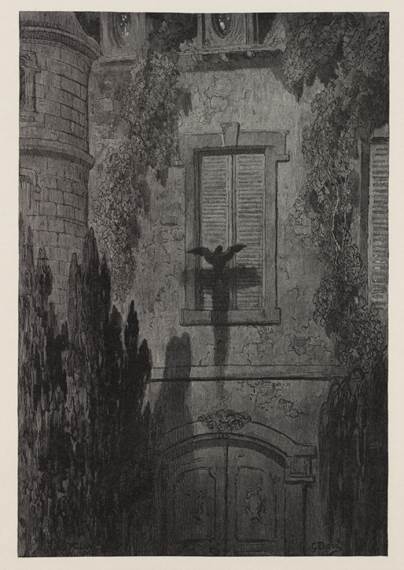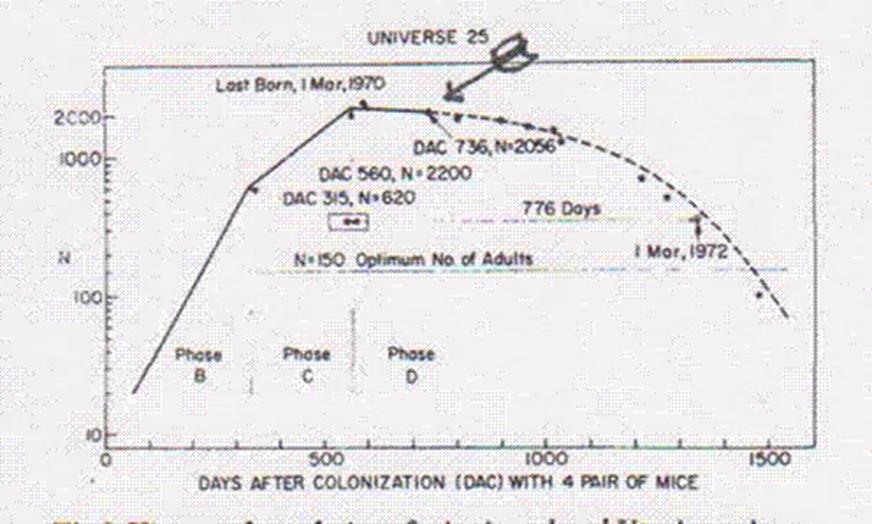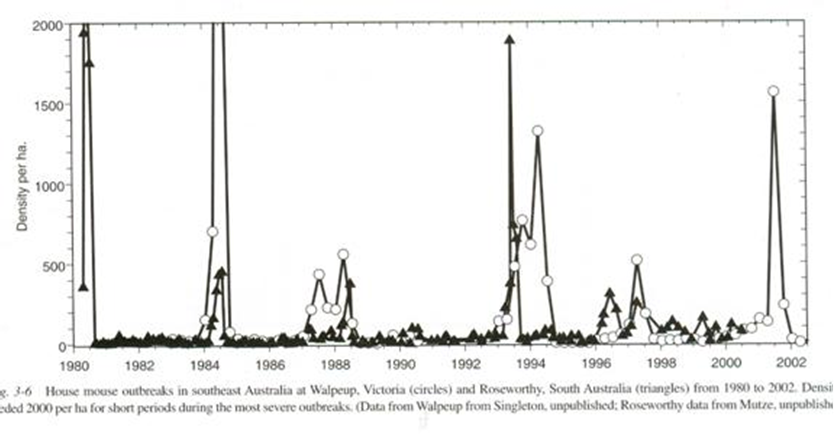Most Dreaded Terror 18 Calhoun

Dore “Raven”
https://hyperallergic.com/102457/rediscovering-the-dark-splendor-of-gustave-dore-with-edgar-allan-poe/ downloaded Feb 18, 2018
It is the 5th of April, 2018 We are still closing in on the mechanism that links kinship and fertility.
Back in 1973 a man named J. Calhoun published in Proceedings of the Royal Society of Medicine what I regard as the classical study in the field. He built a large cage for mice with plenty of nesting places and material and assured there would be plenty of food and water; then he released four males and four females in the box. Hed observed their behavior and counted them periodically. Here is how the population changed over time.

J. Calhoun, Death squared: the explosive growth and demise of a mouse population. Proceedings of the Royal Society of Medicine 66, 80-88 (1973).
Obviously the population grew explosively until it reached two thousand mice. Then it grew more slowly to about two thousand. Then sometime between day 500 and day 600 all live births ceased, never to return. Unlike some previous data sets in which the size of the population had to be inferred from survivability or evidence of cook fires, these are counts in a laboratory. I should not have been sorry if the counts had been done more frequently, particularly around the beginning of the experiment, but the pattern is clear: one rise, one fall, extinction. Actually at the time indicated by the little arrow, he stopped counting the live mice and started counting the dead ones, and on day one thousand five hundred, ended the study; there had been no live births for a long time, and the mice were all too old to reproduce anyway. At one point after the last live birth he removed a few males and placed them with females known to be fertile. The males took no interest in the females, and there were no babies. In other words, males raised in the cage after a number of generations experienced absolute infertility. I am not sure whether it was post-zygotic (males hard wired for abnormal behavior) or pre-zygotic (sperm never getting to ova).
There may be a clue in their behavior, which he carefully described. For one thing, the mice promptly showed a preference for one corner of the cage, choosing to use nesting boxes there until all the boxes were filled and on the two adjacent sides the number of boxes occupied dropped steadily and continue to drop past the two corners. The corner farthest from the preferred corner never had any boxes occupied at all. The temptation is very strong to interpret this so mean that the mice were showing a preference of high status both in location choice and mating choices.
As the mice become more crowded most of the unattached males would stay gathered in the center of the cage. When one left to eat or get a drink of water it would be attacked when it returned. Some of the males – Calhoun calls them the “beautiful ones” neither competed for females nor entered the brawling world of the disappointed males. Instead they would get away from all the others and spend their time grooming. Again, there is a strong temptation to liken them to young urban male humans who, at a time for low reproductive rate, may largely withdraw from social contact. In the absence of valid numbers it seems hard to draw conclusions.
Now look again at the mouse plague data we saw before.

G. R. Singleton, C. J. Krebs, “The secret world of wild mice” in The Mouse in Biomedical Research, J. G. Fox, M. T. Davisson, F. W. Quimby, S. W. Barhold, C. E. Newcomer, A. L. Smith, Eds. (Elsever, Burlington, ed. 2, 2007), vol. 1, chap. 3, p. 39.
As I mentioned earlier, the populations tend to be small and stable in a fashion I have not had much success in getting my model to give. Since my source code is available through nobabies.net I invite anyone to have a go at it.
Something that is not conspicuous and possibly not present is the damped oscillation pattern shown by my fruit flies and by European voles. It may be hidden at the bottom, of course.
Then there is the double peak pattern I also described, which appears to be something that humans have a distinct tendency to follow. It seems odd that mice and humans share a pattern that we do not share with flies or voles. Voles, like mice, are rodents. Yet they do not share the same patterns, at least not conspicuously. We shall have to return to this point.
What is most conspicuous is the single peak pattern. Four times the data show huge populations that then crash. The authors make clear that even at the height of a plague the mice are never short on food. And available predators simply were not capable of eating enough mice to bring their numbers back down. The authors suggest there may be a virus affecting the mice, but that is only a matter of exclusion; they have ruled out everything else they can think of.
In normal times a male mouse will be very territorial, defending its little domain and its females most fiercely. But during a plague they seem to give up keeping all those others out; other males can pass with impunity.
What I suspect is that during the high population peaks, the fertility of the males drops to zero, just as in Calhoun’s cage. The rapid fall may be due to the fact that life in the wild is a lot more difficult than in the friendly cage. The males do not seem to be fighting each over to the death; injuries are no more frequent than at baseline. The brawling in the cage is not described among the plague mice, but surely the crowding even in the biggest plagues cannot be anything like the crowding in the cage.
I suspect the rapid fall is related to the behavior of Calhoun’s “beautiful ones.” If they can’t be bothered to defend their territory they may not put the effort in to scour around and find something to eat – something my mother used to call “survival value.” They may be starving in the midst of plenty.
I do not know; I only suspect. And I don’t have a suggestion of how to find out. But one thing is perfectly clear: the plague mice tend to show the same single peak curve as Calhoun’s mice.
YouTube video script directory
Home page


